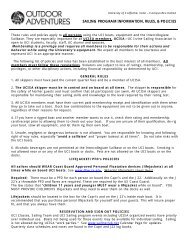J22 Manual - UCI Campus Recreation
J22 Manual - UCI Campus Recreation
J22 Manual - UCI Campus Recreation
Create successful ePaper yourself
Turn your PDF publications into a flip-book with our unique Google optimized e-Paper software.
<strong>UCI</strong> J/22 Sailing <strong>Manual</strong> 30<br />
know you expect it to give way. The port tack boat, for example, may respond with “hold your<br />
course”.<br />
Note on the Balboa Ferry<br />
You should always avoid the ferries. They have to be able to cross the channel, and have limited<br />
maneuverability and limited areas in which they can alter their course. It would be impossible<br />
for them to operate if other boaters did not keep clear. There are 2 or 3 ferries operating at a<br />
time. As you approach, identify where they are, and plan your passage. Do not cut in front or<br />
try to squeeze by them along the docks. It is best to pass behind them and it is easy to do if you<br />
plan ahead. You can always just tack away for a few minutes and then pass when it is safe.<br />
The ferries in Newport are square with two wheelhouses so the captain can face both ways. To<br />
determine which direction the ferry is headed you need to consider the direction the cars are<br />
facing on the ferry. Aim to pass on the side near the car trunks.<br />
Further information on right of way and safety rules as well as sounds, lights and channel<br />
markings, may be found in the “ABC of the California Boating Law”. This is a free publication<br />
provided by the California Department of Boats and Waterways and is available at the Harbor<br />
Patrol and on the Internet at www.dbw.co.gov . Your instructor can also provide copies of this<br />
booklet.<br />
These are just the basics. If you ever sail in a harbor with commercial traffic such as San Diego,<br />
Long Beach or the Port of LA, you will need to learn more and know the specific rules for that<br />
area.<br />
Anchoring<br />
Anchoring can be used when you have an emergency such as a breakdown or medical<br />
emergency. If you need to anchor for an emergency, you will need to be able to do it fast and<br />
efficiently. Understanding the theory and practice will make anchoring easier and safer. Be sure<br />
you know how you are going to get back aboard when anchoring.<br />
Our J/22's are equipped with Danforth anchors, chain and about 100 feet of line. This type of<br />
anchor holds well, in sand or mud, but not as well in kelp or rocks.<br />
Anchor Theory<br />
The anchor we use on the J/22 has been carefully optimized to be a lightweight, effective<br />
system. The eight-pound model on the <strong>UCI</strong> J/22 has a maximum holding power of over 3,000<br />
pounds in hard sand. In order to achieve this holding power, the pull on the anchor line should<br />
be at an angle of not more than 8 degrees to the bottom. This brings us to a discussion of scope<br />
since it is not the weight of the anchor that holds the boat. Instead, the design of the anchor<br />
along with the scope used in setting the anchor and to a much lesser extent the weight of the







